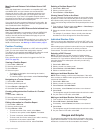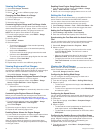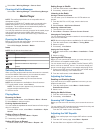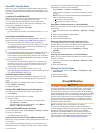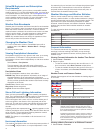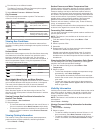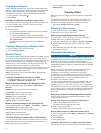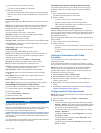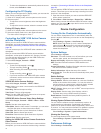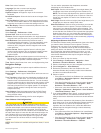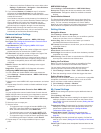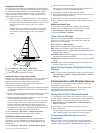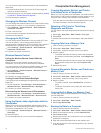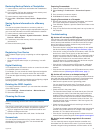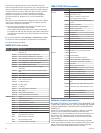
1
From a video screen, touch the screen.
The video controls appear on the screen.
2
Select a video preset.
The camera restores the video settings saved for that preset.
TIP: You can also save and activate presets using the video
menu.
Camera Settings
Some cameras provide additional options to control the camera
view.
NOTE: Not all options are available on all camera models and
chartplotter models. Refer to the camera manual for a list of
available features. You may need to update the camera
software to use this feature.
From the infrared video screen, select Menu.
IR/Visible: Displays an infrared or visible camera image.
Scan: Surveys the surrounding area.
Freeze: Pauses the camera image.
Change Colors: Selects the color scheme of the infrared image.
Change Scene: Selects the infrared image mode, such as day,
night, MOB, or docking.
Video Setup: Opens more video options.
Video Settings
Some cameras provide additional setup options.
NOTE: Not all options are available on all camera models and
chartplotter models. You may need to update the camera
software to use this feature.
From the video screen, select Menu > Video Setup.
Set Input: Associates the camera with a video source.
Mirror: Reverses the image like a rearview mirror.
Standby: Places the camera in standby mode to conserve
power and protect the lens when not in use.
Home Position: Sets the home position of the camera.
Scan Speed: Sets how quickly the camera moves during a
scan.
Scan Width: Sets the width of the image captured by the
camera during a scan.
Name: Allows you to enter a new name for this camera.
FLIR™ Menu: Provides access to the settings for the camera.
Associating the Camera to a Video Source
You may need to associate the camera with a video source.
1
From the video screen, select Menu > Source.
2
Select the camera.
3
Select Video Setup > Set Input.
4
Select the video input.
Video Camera Movement Control
NOTICE
Do not aim the camera at the sun or extremely bright objects.
Damage to the lens may occur.
Always use the chartplotter controls or buttons to pan and tilt the
camera. Do not manually move the camera unit. Manually
moving the camera may damage the camera.
NOTE: This feature is available only when a compatible camera
is connected. You may need to update the camera software to
use this feature.
You can control the movements of the connected video cameras
that support panning, tilting, and zooming.
Controlling Video Cameras Using On-Screen Controls
On-screen controls allow you to control pan-tilt-zoom (PTZ)
cameras. Refer to the camera manual for a list of available
features.
1
From a video screen, touch the screen.
The video controls appear on the screen.
2
Select an option:
• To zoom in and out, use the zoom button.
• To pan or tilt the camera, use the compass rose.
TIP: Hold in the compass rose to continue to move the
camera in the desired direction.
Controlling a Video Camera Using Gestures
When a networked video camera supports gesture responses,
you can control pan-tilt-zoom cameras using gestures directly on
the chartplotter screen. Check your camera user manual for a
list of available features.
TIP: Using gestures allows video control without displaying the
video controls.
1
From a video screen, touch the screen.
2
Select an option:
• To zoom in and out with the camera, use pinch and zoom
gestures.
• To pan or tilt the camera, swipe the screen in the desired
direction.
Creating a Combination with Video
Functions
You can include up to four video functions in a custom
combination screen.
If your device has multiple built-in video connections, you can
use one built-in source for one function within each combination.
NOTE: The video source displays all connected, supported
video devices. You can select Show All to see a list of all
possible video inputs or video encoder channels that are not
connected to a video input source.
1
Select Combos > Menu > Add Combo.
2
Select Functions, and select a number.
3
Select an area to assign a function to, select Video, and
select a video source.
4
Repeat step 3 for all video functions in the combination
screen.
5
If necessary, customize the combination screen (Adding a
Custom Combination Screen, page 2).
Configuring the Video Appearance
NOTE: Not all options are available on all camera models and
chartplotter models.
1
From the video screen, select Menu > Video Setup.
2
Select an option:
• To show the video using a stretched aspect ratio, select
Aspect > Stretch. The video cannot be stretched beyond
the dimensions provided by the connected video device,
and it may not fill the entire screen.
• To show the video using a standard aspect ratio, select
Aspect > Standard.
• To adjust the brightness, select Brightness, and select
Up, Down, or Auto.
• To adjust the color saturation, select Saturation, and
select Up, Down, or Auto.
• To adjust the contrast, select Contrast, and select Up,
Down, or Auto.
Viewing Video 35



